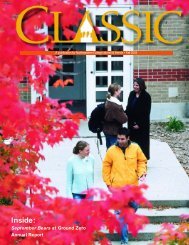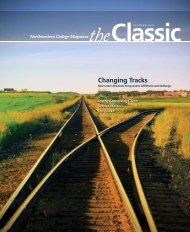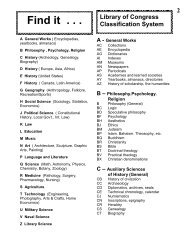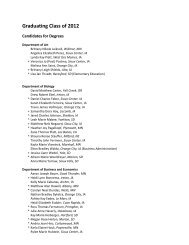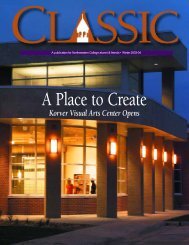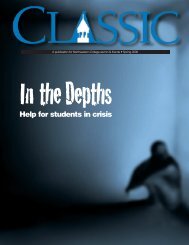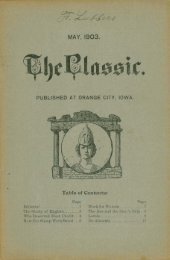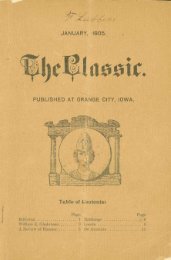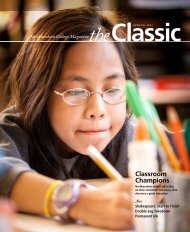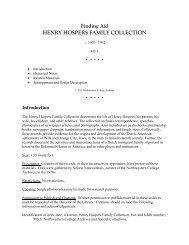Northwestern College | Classic magazine - Winter 2004-05 - Vol. 76 ...
Northwestern College | Classic magazine - Winter 2004-05 - Vol. 76 ...
Northwestern College | Classic magazine - Winter 2004-05 - Vol. 76 ...
- No tags were found...
You also want an ePaper? Increase the reach of your titles
YUMPU automatically turns print PDFs into web optimized ePapers that Google loves.
Piet Koene<strong>Northwestern</strong> <strong>Classic</strong>Facultyprofileheadsets on, students workin pairs to interpret to eachother as I tell them about mykids. A common mistake iscaught by some—forgettingto translate “four years old”into the correct order inSpanish: “He has four years.”After several rounds,Koene sits next to me andinterprets as I speak, thistime about my work in theatre.The students knowvocabulary for the threefields the course covers—court, clinic and church—soa discussion ensues abouthow to communicate the terminologyof unfamiliar fields.“My roommate says Ihave the weirdest homework,”junior Jackie Carlsontells me after class. Arguably,it’s some of the most difficultas well. Exercises vary fromsimple shadowing of English(repeating spoken Englishafter a slight delay) to dualtasking (shadowing whiledoing something else, suchas writing numbers 1-100, orcopying sections from aphone book).“It’s about training yourear, training your brain,”Carlson says, and she hasproof that Koene’s methodswork. When Koene interpretsat the Sioux CountyCourthouse, or for AmistadCristiana, a local Spanishspeakingchurch, the studentsare often there toobserve his skills.“In the court system, thechallenge for an interpreter isto convey all the littlenuances of the original language,because what you areinterpreting will either setsomebody free or convictEvery week, Koene, his wife, Rosa, and their sons, Johannes (15) and Piet-Albert (10), share a meal with the four residents of<strong>Northwestern</strong>’s Spanish House.somebody,” Koene says. Atchurch, “you’re interpretingwhat God is saying throughthe minister, and nowthrough you. Mentally, that’suppermost in my mind.”▼“That is what I would liketo see as much as possible:the Hispanics and the studentslearning from eachother. It is not the idea ofgoing and helping somebody;slowly a friendship isbuilt, a two-way street. Bylearning Spanish, there isso much you can learnfrom other cultures.”▲To his students who arestruggling, Koene likes topoint out he was just a fewyears younger than theirpresent age when he beganhis study of Spanish. Koene’sparents, immigrants from theNetherlands living inCanada, devised a plan tosend their shy, introvertedson to Honduras, where theirdaughter was a missionary.He finished grade 12 via correspondenceand returned toCanada a changed man.“After that one year ofbeing in Honduras, I learnedto be comfortable withstrangers; everything I wasuncomfortable with inEnglish, I learned to becomecomfortable with in Spanish.My personality changedwhile in Honduras, but inSpanish.”Koene met his futurewife, Rosa, during that time,and they married six yearslater. They lived in Canadafor 10 years, then movedback to Honduras in 1997,where Koene worked as adairy farmer. In Orange Citysince 2000, Koene, Rosa andtheir two sons live on a largeacreage, where they entertainmostly Hispanic friends andspeak only Spanish in theirhome.Koene recognizes theirony of being a DutchCanadian living in a DutchMidwestern town whilespending most of his timewith Hispanics. Yet he pointsto the similarities betweenhis background and that ofSioux County’s Hispanicimmigrants, and an emphasisshared between the Hispanicand Dutch cultures: a strongfocus on family and people.Students take their cuefrom Koene and seek out15 ▲ <strong>Winter</strong> <strong>2004</strong>-<strong>05</strong>



